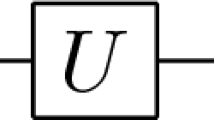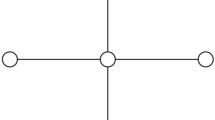Abstract
We study the costs and benefits of different quantum approaches to finding approximate solutions of constrained combinatorial optimization problems with a focus on the maximum independent set. Using the Lagrange multiplier approach, we analyze the dependence of the output on graph density and circuit depth. The Quantum Alternating Operator Ansatz approach is then analyzed, and we examine the dependence on different choices of initial states. This approach, although powerful, is expensive in terms of quantum resources. We also introduce a new algorithm, the dynamic quantum variational ansatz (DQVA), that dynamically adapts to ensure the maximum utilization of a fixed allocation of quantum resources. Our analysis and the new proposed algorithm can also be generalized to other related constrained combinatorial optimization problems.










Similar content being viewed by others
References
Ambühl C, Mastrolilli Monaldo. Single machine precedence constrained scheduling is a vertex cover problem. Algorithmica. 2009;53(4):488.
Arrazola JM, Bergholm V, Brádler K, Bromley TR, Collins MJ, Dhand I, Fumagalli A, Gerrits T, Goussev A, Helt LG, et al. Quantum circuits with many photons on a programmable nanophotonic chip. Nature. 2021;591(7848):54–60.
Arute F, Arya K, Babbush R, Bacon D, Bardin JC, Barends R, Biswas R, Boixo S, Brandao FGSL, Buell DA, et al. Quantum supremacy using a programmable superconducting processor. Nature. 2019;574(7779):505–10.
Auyeung A, Abraham A. The largest compatible subset problem for phylogenetic data. 2004. arXiv preprint arXiv:cs/0405025.
Cain M, Farhi E, Gutmann S, Ranard D, Tang E. The qaoa gets stuck starting from a good classical string, 2022. arXiv:2207.05089.
Chen S, Liu Y, Otten M, Seif A, Fefferman B, Jiang L. The learnability of pauli noise. 2022. arXiv preprint arXiv:2206.06362.
Crooks GE. Performance of the quantum approximate optimization algorithm on the maximum cut problem. 2018. arXiv preprint arXiv:1811.08419.
Dalzell AM, Harrow AW, Koh DE, La Placa RL. How many qubits are needed for quantum computational supremacy? Quantum. 2020;4:264.
Egger DJ, Mareček J, Woerner S. Warm-starting quantum optimization. Quantum. 2021;5:479.
Farhi E, Harrow AW. Quantum supremacy through the quantum approximate optimization algorithm. 2016. arXiv preprint arXiv:1602.07674.
Farhi E, Goldstone J, Gutmann S. A quantum approximate optimization algorithm. 2014. arXiv preprint arXiv:1411.4028.
Farhi E, Gamarnik D, Gutmann S. The Quantum Approximate Optimization Algorithm needs to see the whole graph: worst case examples. 2020. arXiv preprint arXiv:2005.08747.
Farhi E, Gamarnik D, Gutmann S. The Quantum Approximate Optimization Algorithm needs to see the whole graph: a typical case. 2020. arXiv preprint arXiv:2004.09002.
Fuchs FG, Lye KO, MøllNilsen H, Stasik AJ, Sartor G. Constraint preserving mixers for the quantum approximate optimization algorithm. Algorithms. 2022;15(6):202.
Gambetta JM, Chow JM, Steffen M. Building logical qubits in a superconducting quantum computing system. npj Quantum Inf. 2017;3(1):1–7.
Hadfield S, Wang Z, O’Gorman B, Rieffel EG, Venturelli D, Biswas R. From the quantum approximate optimization algorithm to a quantum alternating operator ansatz. Algorithms. 2019;12(2):34.
Hadfield SA. Quantum algorithms for scientific computing and approximate optimization. Columbia University; 2018.
He Y, Luo M-X, Zhang E, Wang H-K, Wang X-F. Decompositions of n-qubit Toffoli gates with linear circuit complexity. Int J Theoret Phys. 2017;56(7):2350–61.
Herrman R, Ostrowski J, Humble TS, Siopsis G. Lower bounds on circuit depth of the quantum approximate optimization algorithm. Quantum Inf Process. 2021;20(2):1–17.
Kalra A, Qureshi F, Tisi M. Portfolio asset identification using graph algorithms on a quantum annealer. 2018 Available at SSRN 3333537.
Karp RM. Reducibility among combinatorial problems. In: Complexity of computer computations: proceedings of a symposium on the complexity of computer computations, held March 20–22, 1972, at the IBM Thomas J. Watson Research Center, Yorktown Heights, New York, and sponsored by the Office of Naval Research, Mathematics Program. IBM World Trade Corporation, and the IBM Research Mathematical Sciences Department, Springer, US; 1972. p. 85–103.
Lucas A. Ising formulations of many NP problems. Front Phys. 2014;2:5.
Pichler H, Wang S-T, Zhou L, Choi S, Lukin MD. Quantum optimization for maximum independent set using rydberg atom arrays. 2018. arXiv preprint arXiv:1808.10816.
Porras D et al. Hybrid quantum-classical optimization for financial index tracking. 2021. Technical report, arXiv. org.
Preskill J. Quantum computing in the NISQ era and beyond. Quantum. 2018;2:79.
Safar M, Habib S. Hard constrained vertex-cover communication algorithm for WSN. In: International Conference on embedded and ubiquitous computing, Vol. 4808. 2007; p. 635–649. Springer.
Saffman M. Quantum computing with atomic qubits and Rydberg interactions: progress and challenges. J Phys B: At Mol Opt Phys. 2016;49(20): 202001.
Saffman M. Quantum computing with neutral atoms. Natl Sci Rev. 2019;6(1):24–5.
Saleem ZH, Tomesh T, Perlin MA, Gokhale P, Suchara M. Quantum divide and conquer for combinatorial optimization and distributed computing. 2021. arXiv preprint arXiv:2107.07532.
SaleemZain H. Max-independent set and the quantum alternating operator ansatz. Int J Quantum Inf. 2020;18(04):2050011.
Schön C, Hammerer K, Wolf MM, Cirac JI, Solano E. Sequential generation of matrix-product states in cavity QED. Phys Rev A. 2007;75(3):032311.
Shaydulin R, Lotshaw PC, Larson J, Ostrowski J, Humble TS. Parameter transfer for quantum approximate optimization of weighted maxcut. 2022. arXiv preprint arXiv:2201.11785.
Shende VV, Markov IL. On the CNOT-cost of TOFFOLI gates. Quantum Inf Comput. 2009;9(5):461–86 (ISSN 1533-7146).
Tomesh T. quantum-constrained-optimization. 2022. https://github.com/teaguetomesh/quantum-constrained-optimization.
Tomesh T, Saleem ZH, Suchara M. Quantum local search with the quantum alternating operator ansatz. Quantum. 2022;6:781.
Virtanen P, Gommers R, Oliphant TE, Haberland M, Reddy T, Cournapeau D, Burovski E, Peterson P, Weckesser W, Bright J, van der Walt SJ, Brett M, Wilson J, Jarrod MK., Mayorov N, Nelson ARJ, Jones E, Kern R, Larson E, Carey C J, Polat İ, Feng Y, Moore EW, Vander Plas J, Laxalde D, Perktold J, Cimrman R, Henriksen I, Quintero E.A, Harris CR, Archibald AM, Ribeiro AH, Pedregosa F, van Mulbregt P, SciPy 1.0 Contributors.. SciPy 10: fundamental algorithms for scientific computing in Python. Nat Methods. 2020;17:261–72. https://doi.org/10.1038/s41592-019-0686-2.
Wang H, Ashhab S, Nori F. Efficient quantum algorithm for preparing molecular-system-like states on a quantum computer. Phys Rev A. 2009;79(4):042335.
Wang Z, Hadfield S, Jiang Z, Rieffel EG. Quantum approximate optimization algorithm for MaxCut: a fermionic view. Phys Rev A. 2018;97(2): 022304.
Wang Z, Rubin NC, Dominy JM, Rieffel EG. XY mixers: analytical and numerical results for the quantum alternating operator ansatz. Phys Rev A. 2020;101(1): 012320.
Wright K, Beck KM, Debnath S, Amini JM, Nam Y, Grzesiak N, Chen JS, Pisenti NC, Chmielewski M, Collins C, et al. Benchmarking an 11-qubit quantum computer. Nat Commun. 2019;10(1):1–6.
Acknowledgements
We thank Kaiwen Gui, Brajesh Gupt, Ruslan Shaydulin, Stuart Hadfield, and James Stokes for the helpful discussions. This material is based on work partly supported by the National Science Foundation under Award No. 2037984 and partly by Laboratory Directed Research and Development (LDRD) funding from Argonne National Laboratory, provided by the Director, Office of Science, of the U.S. Department of Energy under Contract No. DE-AC02-06CH11357. T.T. is supported in part by EPiQC, an NSF Expedition in Computing, under Grant No. CCF-1730082.
Author information
Authors and Affiliations
Corresponding author
Ethics declarations
Conflict of Interest
On behalf of all authors, the corresponding author states that there is no conflict of interest.
Additional information
Publisher's Note
Springer Nature remains neutral with regard to jurisdictional claims in published maps and institutional affiliations.
The submitted manuscript has been created by UChicago Argonne, LLC, Operator of Argonne National Laboratory (“Argonne”). Argonne, a U.S. Department of Energy Office of Science laboratory, is operated under Contract No. DE-AC02-06CH11357. The U.S. Government retains for itself, and others acting on its behalf, a paid-up nonexclusive, irrevocable worldwide license in said article to reproduce, prepare derivative works, distribute copies to the public, and perform publicly and display publicly, by or on behalf of the Government. The Department of Energy will provide public access to these results of federally sponsored research in accordance with the DOE Public Access Plan (http://energy.gov/downloads/doe-public-access-plan).
Rights and permissions
Springer Nature or its licensor (e.g. a society or other partner) holds exclusive rights to this article under a publishing agreement with the author(s) or other rightsholder(s); author self-archiving of the accepted manuscript version of this article is solely governed by the terms of such publishing agreement and applicable law.
About this article
Cite this article
Saleem, Z.H., Tomesh, T., Tariq, B. et al. Approaches to Constrained Quantum Approximate Optimization. SN COMPUT. SCI. 4, 183 (2023). https://doi.org/10.1007/s42979-022-01638-4
Received:
Accepted:
Published:
DOI: https://doi.org/10.1007/s42979-022-01638-4




